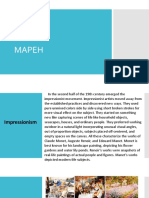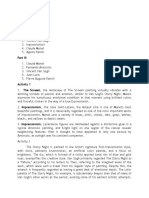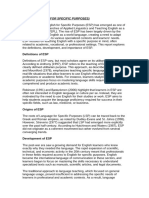0 ratings0% found this document useful (0 votes)
4 viewsArts 1st Quarter Reviewer
Arts 1st Quarter Reviewer
Uploaded by
hershannnCopyright:
© All Rights Reserved
Available Formats
Download as PDF, TXT or read online from Scribd
Arts 1st Quarter Reviewer
Arts 1st Quarter Reviewer
Uploaded by
hershannn0 ratings0% found this document useful (0 votes)
4 views4 pagesCopyright
© © All Rights Reserved
Available Formats
PDF, TXT or read online from Scribd
Share this document
Did you find this document useful?
Is this content inappropriate?
Copyright:
© All Rights Reserved
Available Formats
Download as PDF, TXT or read online from Scribd
Download as pdf or txt
0 ratings0% found this document useful (0 votes)
4 views4 pagesArts 1st Quarter Reviewer
Arts 1st Quarter Reviewer
Uploaded by
hershannnCopyright:
© All Rights Reserved
Available Formats
Download as PDF, TXT or read online from Scribd
Download as pdf or txt
You are on page 1of 4
VARIOUS ART MOVEMENTS - Artists moved away from
the established practices
Principles of Art and discovered new ways
- Balance - Impressionism in arts is
- Emphasis similar to impressionism in
- Contrast music because they are
- Repetition happening simultaneously
- Unity Characteristics of Impressionism
- Proportion - Uses bright and vibrant
- Variety colors
Modern Art - Capture their images
- Refers to works produce without detail but with bold
during the approximate colors
period 1870-1970 - Applying paint in small
- Rejection of traditional touches of pure color rather
academic art forms than border strokes
- New forms of artistic - Painting out of doors to
experimentation catch a particular fleeting
- Color and Light impression of color and light
- “Everyday subjects” - Everyday subjects
- Painting outdoors - Open composition
- Open Composition Claude Monet (1840-1926)
- Influence of photography - Wasn’t the first to paint this
Various Art Movements in the way, but the first to be
age of “Modern Art” “accepted” and called an
- Impressionism Impressionist
- Expressionism - Most influential figure in the
- Abstractionism moment
- Abstract Expressionism - Main subjects were nature
- Contemporary Arts and landscapes particularly
Impressionism those depicting his beloved
- Art movement that flower gardens and water
emerged in the second half lily ponds at his home in
of the 19th century among a Giverny
group of Paris-based artists - Painted same scenes day
- Characterized by a concern after day to capture
with depicting the visual changing of light weather,
impression of the moment, atmosphere, and the
especially in terms of the changing of seasons
shifting effect of light and
color
Pierre-Auguste Renoir (1841-1919) Post-impressionism
- Suggested the details of a - Using geometrical approach
scene through freely - Fragmenting objects and
brushed touches of color, so distorting people’s faces
that his figures softly fuse and body parts
with one another and their - Applying colors that were
surroundings not necessarily realistic or
- Vibrant light and saturated natural
color Characteristics of
- Focused on people in Post-impressionism
intimate and candid - Symbolic and highly
compositions personal meanings
- Females were his primary - Structure, order, and the
subjects optical effects of color
- Later in life he went back to dominated the aesthetic
more traditional style of vision
painting - Relied on the interrelations
of colors and shape to
describe the world
- Focused on abstract form
and pattern in the
application of paint
Paul Cezanna (1839-1906)
Edouard Manet (1832-1883)
- French artist and
- One of the first 19th-century
post-impressionist
artists to paint modern life,
- Work exemplified the
and a pivotal figure in the
transition from late 19th
transition from Realism to
century impressionism to a
Impressionism
new and radically different
- Classical artist, but then
world of art in 20th century
‘adopted’ the notions of
impressionism
- Well known for his social
scenes
Vincent Van Gogh (1853-1890)
- Post-impressionist from
Netherlands
- Works became the most
recognized in the world
- Remarkable work with 2. Fauvism
strong, heavy brush strokes, - Artist: Henri Matisse
intense emotions and colors - Known for its vivid,
appeared to almost pulsate non naturalistic, and
energy exuberant paintings
with bold color and
EXPRESSIONISM large brushstrokes
- Overall goal is to
Characteristics of Expressionism express emotion
- Convey emotion and through the color of
meaning rather than reality paints
- Each artist had their own
unique way of “expressing”
their emotions in their art
- The subjects are often
distorted or exaggerated
-
- Colors are often vivid and
3. Dadaism
shocking
- Artists: Marc Chagall
Art Movements
and Giorgio de Chirico
1. Neo-Primitivism
- Styles characterized
- Artist: Amedeo
by dream fantasies,
Modigliani
memory images, and
- Art style of combined
visual tricks, and
elements from the
surprises
native arts of the
- Artists turn their
south sea Islanders
backs from using
and the wood
traditional styles in
carvings of African
arts leading to their
Tribes
new style called
- Oval faces and
“non-style”
elongated shapes of
African art in both
sculptures and
paintings
-
4. Surrealism
- Artists: Salvador Dali,
Paul Klee, Joan Miro
- Depicts an illogical,
subconscious dream
world
- Appeared morbid or
gloomy subjects
- Clear expression of
departure from reality
-
5. Social Realism
- Artists: Ben Shahn
and Pablo Picasso
- Expresses the artists
role in social reform
- Artists used their
works to show protest
against the injustices,
in equality, immorality,
and other concern of
the human condition
You might also like
- Hydraulic Mining Shovel: Remove & Replace ProceduresDocument918 pagesHydraulic Mining Shovel: Remove & Replace ProceduresKoke Calbueque100% (6)
- MICE EV5011FP Project Brief - Student's PDFDocument6 pagesMICE EV5011FP Project Brief - Student's PDFRealSos SiQNo ratings yet
- Arta Finals Reviewer PDFDocument30 pagesArta Finals Reviewer PDFxuxi dul100% (1)
- B737 200FDocument2 pagesB737 200FNadeem100% (2)
- FORM 2B - Word FormatDocument6 pagesFORM 2B - Word FormatKannan Muthusamy100% (1)
- Imagination and The Arts in C. S. Lewis (Schakel)Document232 pagesImagination and The Arts in C. S. Lewis (Schakel)Noe Ferrero100% (1)
- Started Composing Chance Music in 1951. - Famous Composition 4'33Document3 pagesStarted Composing Chance Music in 1951. - Famous Composition 4'33Franz PrudenciadoNo ratings yet
- MODERN ART 10'1st QuarterDocument30 pagesMODERN ART 10'1st QuarterEllen Grace GenetaNo ratings yet
- Impressionism: Works of Monet, Renoir, and Manet: (Impression, Sunrise)Document3 pagesImpressionism: Works of Monet, Renoir, and Manet: (Impression, Sunrise)Zyreen Silva Giduquio100% (2)
- G10 Q1 Arts Module 1Document19 pagesG10 Q1 Arts Module 1Manuel Rosales Jr.50% (2)
- 2Q Mapeh ReviewerDocument2 pages2Q Mapeh ReviewerNadine GatullaNo ratings yet
- M A P E H 3rd QuarterDocument8 pagesM A P E H 3rd QuarterNinna Theresa De LeonNo ratings yet
- Arts 10 Q1Document3 pagesArts 10 Q1Chelsy Kate CastigonNo ratings yet
- Impressionism, Expressionism and CubismDocument2 pagesImpressionism, Expressionism and CubismCHAPEL JUN PACIENTENo ratings yet
- Arts Q1Document54 pagesArts Q1Lorna A. TobiasNo ratings yet
- 1 - Modern Art - Impressionism, Expressionism Cubism (21-22)Document50 pages1 - Modern Art - Impressionism, Expressionism Cubism (21-22)Yevgeni Alexis Torres100% (4)
- PAINTING (Modern and Contemporary Period)Document14 pagesPAINTING (Modern and Contemporary Period)Sittie Asraleah AgatonNo ratings yet
- Grade10artsq1modernartbyme 180627160815Document53 pagesGrade10artsq1modernartbyme 180627160815Elno Jay Jamog MallorcaNo ratings yet
- MAPEHDocument4 pagesMAPEHChelsy Kate CastigonNo ratings yet
- Lecture in Arts 1st GradingDocument4 pagesLecture in Arts 1st GradingbaoingarjayNo ratings yet
- Group 1 - Arts (Impressionism and Expressionism)Document43 pagesGroup 1 - Arts (Impressionism and Expressionism)Zia RanileNo ratings yet
- 1Q Arts Las G10Document12 pages1Q Arts Las G10chloefloresta83No ratings yet
- Welcome To The Next 100 Years of Art HistoryDocument28 pagesWelcome To The Next 100 Years of Art HistoryHeroe SedicoNo ratings yet
- Arts 10 - Q1Document76 pagesArts 10 - Q1Rjay NagilNo ratings yet
- Elements and Principles of ArtsDocument4 pagesElements and Principles of ArtsJustine Renée CruzNo ratings yet
- Arts Reviewer Long TestDocument5 pagesArts Reviewer Long TestDewi MiraflorNo ratings yet
- Grade10artsq1modernartbyme 180627160815Document53 pagesGrade10artsq1modernartbyme 180627160815Cydeizel MercadoNo ratings yet
- Module 1. ImpressionismDocument7 pagesModule 1. ImpressionismEj CarNo ratings yet
- Arts PTDocument7 pagesArts PTaionix thedeathbringerNo ratings yet
- REALISM-the Attempt To Portray The Subject As It IsDocument2 pagesREALISM-the Attempt To Portray The Subject As It IsCrizza Mae CuregNo ratings yet
- Modern Art and Contemporary Art FormsDocument42 pagesModern Art and Contemporary Art FormsAriane Santos100% (2)
- AART Modern Art IntroDocument52 pagesAART Modern Art Introjanlee.aniceta5507No ratings yet
- MAPEH 10 (Arts) Module 3Document14 pagesMAPEH 10 (Arts) Module 3Celeste De VeraNo ratings yet
- MAPEH 10 (Arts) Module 3Document14 pagesMAPEH 10 (Arts) Module 3Celeste De VeraNo ratings yet
- ARTS 10 Read and Answer (Write Answers On 1 Whole Sheet of Paper-ANSWERS ONLY)Document8 pagesARTS 10 Read and Answer (Write Answers On 1 Whole Sheet of Paper-ANSWERS ONLY)Janine Jerica JontilanoNo ratings yet
- 1ST Quarter Arts PDFDocument12 pages1ST Quarter Arts PDFKung malaman moNo ratings yet
- Grade 10 Mapeh ReviewerDocument18 pagesGrade 10 Mapeh ReviewerkarlosmahinayNo ratings yet
- ArtsDocument5 pagesArtsRhovi Christine AbandoNo ratings yet
- Q1 - MODERN ART (Week 2)Document98 pagesQ1 - MODERN ART (Week 2)jocelmay.taboradaNo ratings yet
- Quarter I Modern ArtDocument8 pagesQuarter I Modern Artlivija mikicNo ratings yet
- Grade 10 Arts 1ST QuarterDocument46 pagesGrade 10 Arts 1ST QuarterAllen Paul Baltero Antonio89% (18)
- Mapeh 10 Reviewer 1st QuarterDocument4 pagesMapeh 10 Reviewer 1st QuarternanamikentolovergirlNo ratings yet
- Arts ReviewerDocument13 pagesArts ReviewerStudy Shary100% (1)
- Modern ArtDocument94 pagesModern ArtRome Billote100% (2)
- Contemporary Arts HandoutDocument8 pagesContemporary Arts HandoutElaine CuencaNo ratings yet
- Art AppreDocument5 pagesArt AppreBSA - Cabangon, MerraquelNo ratings yet
- Grade 10 Arts PPT Quarter 1 Complete W Assessment 1Document58 pagesGrade 10 Arts PPT Quarter 1 Complete W Assessment 1Regner Borneo100% (1)
- Q1 Arts10 Modules 2 4Document37 pagesQ1 Arts10 Modules 2 4kryzastalmmm16No ratings yet
- 01 - Understanding Humanities, Arts, Art History & Art AppreciationDocument12 pages01 - Understanding Humanities, Arts, Art History & Art AppreciationVoxdeMacNo ratings yet
- Chapter 2.3.3 History of Visual Arts Modernism Post ModernismDocument17 pagesChapter 2.3.3 History of Visual Arts Modernism Post ModernismKim Ashley SarmientoNo ratings yet
- Arts Philippine Theater ProductionDocument4 pagesArts Philippine Theater ProductionMaria LopezNo ratings yet
- Chapter 2.3.3 History of Visual Arts Modernism Post ModernismDocument16 pagesChapter 2.3.3 History of Visual Arts Modernism Post ModernismRuby Alintana PantiNo ratings yet
- HandoutsDocument11 pagesHandoutsCathryn SolitoNo ratings yet
- Impression, Soleil LevantDocument6 pagesImpression, Soleil LevantashNo ratings yet
- An Introduction To The Different Types of PaintingDocument15 pagesAn Introduction To The Different Types of PaintingShiarica Mae NeriNo ratings yet
- Birth of Modern ArtsDocument21 pagesBirth of Modern Artsapi-19905503No ratings yet
- 2nd Week Modern ArtDocument9 pages2nd Week Modern ArtRica Irish DolaogonNo ratings yet
- MAPEH 10 Module 2Document4 pagesMAPEH 10 Module 2Evangeline Galac AbrilNo ratings yet
- Art Appreciation Art and HistoryDocument7 pagesArt Appreciation Art and HistoryChristine LobrigoNo ratings yet
- Technique and Style in PaintingDocument6 pagesTechnique and Style in PaintingLeanne Heart SanchezNo ratings yet
- 3 MapehDocument4 pages3 MapeheboypjmsNo ratings yet
- Impressionism, Post-Impressionism, Neo-Impressionism, Symbolism and Art NouveauDocument40 pagesImpressionism, Post-Impressionism, Neo-Impressionism, Symbolism and Art Nouveauhernandezarvin82No ratings yet
- Forms and Styles of ArtDocument78 pagesForms and Styles of ArtStephanie Ann MARIDABLENo ratings yet
- Popular Artists:: GEOMETRIC Approach, Fragmenting Objects and Distorting People's Faces and Body PartsDocument9 pagesPopular Artists:: GEOMETRIC Approach, Fragmenting Objects and Distorting People's Faces and Body PartsRKGHQ1No ratings yet
- Artistic Inspiration - The Top 500 "In The Style Of" Ai Art PromptsFrom EverandArtistic Inspiration - The Top 500 "In The Style Of" Ai Art PromptsRating: 3 out of 5 stars3/5 (2)
- Lord I Stretch FULLDocument8 pagesLord I Stretch FULLαγαπημένη του ΧριστούNo ratings yet
- Mohd Mopti Bin Yassin V Lembaga Kemajuan Perusahaan Pertanian Negeri Pahang (LKPP) Corp SDN BHD & AnorDocument12 pagesMohd Mopti Bin Yassin V Lembaga Kemajuan Perusahaan Pertanian Negeri Pahang (LKPP) Corp SDN BHD & AnorA random humanNo ratings yet
- Chapter 3 Early Education in Calamba and BinanDocument23 pagesChapter 3 Early Education in Calamba and BinanRhoniel Gerome RomeroNo ratings yet
- Conceptual Framework: Independent Variable (IV) Dependent Variable (DV)Document3 pagesConceptual Framework: Independent Variable (IV) Dependent Variable (DV)farinna latipNo ratings yet
- Pm0uk CMX U Series PDF DataDocument28 pagesPm0uk CMX U Series PDF DataMuhammad IqbalNo ratings yet
- Registrar Surgery Job, FRS Recruitment - IrishJobs - IeDocument3 pagesRegistrar Surgery Job, FRS Recruitment - IrishJobs - IeIbn SinaNo ratings yet
- Timing in TarotDocument8 pagesTiming in TarotamanotnomeraeiNo ratings yet
- Victoriano V Elizalde Rope Workers UnionDocument2 pagesVictoriano V Elizalde Rope Workers UnionVen Xtian TellesNo ratings yet
- Highway Works (MCDHW), Which Comprises Six Separate Volumes. These DocumentsDocument3 pagesHighway Works (MCDHW), Which Comprises Six Separate Volumes. These DocumentsntirugiribambeNo ratings yet
- Instrumentation and Control. Engineering ModelsDocument28 pagesInstrumentation and Control. Engineering Modelsadem ametiNo ratings yet
- Full Stack Web Development SyllabusDocument12 pagesFull Stack Web Development SyllabusAsif AliNo ratings yet
- Lab Report Weed in Crop FieldDocument18 pagesLab Report Weed in Crop FieldfatinnurnaiemahNo ratings yet
- Buku EspDocument123 pagesBuku EspLena Marliana HarahapNo ratings yet
- Monserrat v. Ceron (GR 37078, 27 September 1933)Document2 pagesMonserrat v. Ceron (GR 37078, 27 September 1933)Frances Stephanie Marie100% (2)
- Esp TOPICSDocument11 pagesEsp TOPICSSherene Jane PapellerasNo ratings yet
- Nurul Syamima: Info EducaDocument1 pageNurul Syamima: Info EducaAtiqah MisranNo ratings yet
- My Father Goes To Court Carlo BulosanDocument3 pagesMy Father Goes To Court Carlo Bulosanvada_soNo ratings yet
- U5 Summative - 2017 - BlankDocument10 pagesU5 Summative - 2017 - Blankapi-375439688No ratings yet
- Concentric-Valves-API-609-A (Inglés)Document12 pagesConcentric-Valves-API-609-A (Inglés)whiskazoo100% (3)
- First United Methodist Church RussellvilleDocument2 pagesFirst United Methodist Church Russellvillemss1947No ratings yet
- CHPRP003 Student Assessment v1.2 Assessment Task 3Document9 pagesCHPRP003 Student Assessment v1.2 Assessment Task 3HoneyNo ratings yet
- A Primer of Quaternions - Arthur S. HathawayDocument70 pagesA Primer of Quaternions - Arthur S. HathawayKevin G. RhoadsNo ratings yet
- Psychosocial Support Activity Pack (PSAP) FINAL - 20211123Document62 pagesPsychosocial Support Activity Pack (PSAP) FINAL - 20211123Celina Katherine Talampas MarquezNo ratings yet
- Morning RitesDocument14 pagesMorning RitesJonalyn MempinNo ratings yet
- All Excel Formula List .PDF - 20231203 - 104045 - 0000Document26 pagesAll Excel Formula List .PDF - 20231203 - 104045 - 0000Naman Yadavvv100% (2)

























































































